Jameson Family Farms (Jff), a Family Owned Business
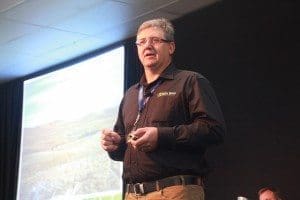
John Gladigau speaks at Beefiness 2015.
What could cattle producers from northern Commonwealth of australia learn from a grain farmer from South Australia?
Plenty, every bit it turns out.
Seven years ago two Mallee graingrowers sat downwardly with a blank canvass of paper and designed the ideal subcontract for their area.
They worked with no preconceptions, no restrictions, and focused only on determining what mix of state, machinery, labour and infrastructure would exist required to create the most efficient and assisting farming business for their surface area.
They take since combined their assets and skill base of operations to create a collaborative family farming enterprise with a corporate focus that has enabled them to achieve a level of calibration, efficiency, profitability and flexibility that they believe would not have been possible had they remained operating as small private family farmers.
And – significantly – they have accomplished this in a very dry corner of Australia, the northern Mallee area of South Australia where the average rainfall is merely xi inches a twelvemonth.
One of those farmers, John Gladigau, kept a room full of northern cattle producers captivated for more than an hour at Beefiness 2015 in Rockhampton earlier this month as he described the journey he and his business partner Robin Schaefer take taken to develop a successful collaborative farming business called Bulla Burra, and why he believes other family unit farmers in the cattle industry could benefit from following a similar path.
An inspiring rebuff
John's farming journey began when he returned dwelling house from schoolhouse in the 1980s to work on his family unit's tertiary-generation, 2000ha cropping subcontract at Alawoona in the northern Mallee, about 250km east of Adelaide.
John describes it equally marginal cropping country. Dry years are mutual and erosion is an ever nowadays threat. Dorsum in the days of conventional tillage Mallee farmers would typically plant their crops in April, May or June, and then hold their collective jiff until Baronial. If the crop was still intact by then, there was unremarkably a decent chance of some sort of event.
Information technology tin also exist "very forgiving land" where things can turn around quickly, John says, noting that wheat yields in the region average around i.2 tonnes to the hectare.
The movement into no-till farming has played a big role in helping Mallee farmers to produce better crops, but at a price. Where conventional farming operations could go away with inexpensive machinery such as a $20,000 air seeder pulled by a $twenty,000 tractor, no-tillage, straight-sowing implements and the tractors equipped with the engineering to drive them tin can toll hundreds of thousands of dollars.
One solar day, at a local christening, John explained that he and several other local broadacre farmers were sitting around and lamenting their lack of profitability and sustainability over a few drinks.
After listening to the group come up with possible solutions to their problems, only to then come with reasons why those ideas wouldn't work, another farmer who managed a large horticulture performance stood up and laid downwardly the police.
"He stood up and said, look guys, it is not that difficult," John recalled. "All you have to do is set yourself up a new visitor, put your farms together to create scale, charter your properties to that new entity, go sell all your machinery, buy the machinery you lot need to farm that new business effectively, put yourself into businesses where you add together the most value and y'all'll be more profitable.
'He slammed downwards his drinking glass and walked off and said 'information technology's non rocket science!'
"And he slammed down his drinking glass and walked off and said 'information technology'south not rocket science!'"
The rebuff inspired John to become away and delve more deeply into the concept of collaborative farming.
He started talking to other farmers and advisors around Australia, and before long discovered that many studies had been conducted suggesting the concept worked. Even so, those studies were all gathering grit in drawers and their findings were either unknown or ignored.
(In an interesting footnote the farmer who stood up at the christening and challenged the group has since been headhunted by Bulla Burra and is now the company'southward subcontract manager).
Nuffield Scholarship opens door to collaborative systems
Inspired to look further, John successfully practical for a Nuffield Scholarship and used the $xxx,000 in funding to visit some of the nearly innovative collaborative farming systems around the world.
While he institute the Nuffield experience "awe inspiring, middle opening and life changing", John said he did not find a silver bullet solution or a single collaborative farming model that he could simply drop into his farming business concern dorsum in the northern Mallee and go far work.
Just what he did find was the key learning that "there is no model, there are no rules": in other words, to create a business that works, yous have to blueprint a business to suit the concern and the environs that information technology is in.
He was also excited to note that people who had successfully developed collaborative farming models overseas had washed and so in regulatory environments that were far more restrictive than he would run into back in Commonwealth of australia.
He as well noticed that each of the successful collaborative farming businesses he visited overseas well-nigh invariably shared the same mutual attributes, which he has distilled down into seven cadre principles that are now at the heart of the Bulla Burra model.
They are:
- Be strategic: "Strategy is actually knowing most where you desire to be, and putting in steps in order to get there. Uncomplicated as that. Start off with a blank slice of paper and design your future."
- Differentiate between agribusiness and real estate: "We are actually running two enterprises – a existent manor business and an operations business concern. Both have to get a render."
- Utilise machinery efficiently: (and labour and infrastructure): "I of the biggest costs particularly to cropping is the toll of machinery. We own half a one thousand thousand dollar harvesters that are used for 3 or four weeks of the year. Look at strategies to maximise the investment in that machinery. It comes down to whether you should be owning that machinery or leasing it or using contractors, and information technology too comes down to the scale of the operation."
- Create cells and replicate them: "Nosotros describe an efficiency cell or a scaleable unit of measurement as the most efficient mix of state, machinery, infrastructure. Once you accept determined what that is then y'all replicate that in order to grow the business."
- Create an environment of win-win: "Relationships are non something that farmers do really well – we're e'er trying to detect a way to go a win at somebody else'southward expense. Nosotros always desire the best toll for our product, we always want to get something for the cheapest price. It is actually the incorrect mental attitude. We need to build win-win relationships between all of the stakeholders throughout our businesses."
- Engage specialist services: "My father always said he was a jack of all trades and a chief of none. The trouble is today, you actually need to be a jack of all trades and a primary of everything. At that place are all these expectations. You can't be everything. You have areas that you are passionate about, there are areas that yous specialise in, but in the areas that you aren't equally proficient in you need to bring in others who are. Actually, actually important considering they tin can add enormous value to your business concern."
- An contained voice is needed: "With every place I went to, I asked what is the biggest threat to this business organization? Every unmarried i of them said: 'Emotion and personalities is the one affair that can destroy this concern, especially in a collaborative business where we are bringing together families.' We believe that the i way of getting around that, the one silvery bullet, is that y'all demand to accept contained people involved in your business. You need a lath with an independent chair, some sort of contained phonation to really come across through the emotion and ensure that everything stays on a professional and accountable level then you can encounter past the emotion, and help people to work things through."
John returned home and shared these fundamental learnings with other farmers via the Nuffield speaking circuit, just said that in his own operation he quickly lapsed back into the old routines and farmed the way he had ever done.
That was until he received another straight brushoff. 1 mean solar day a finance banker, Jeff McDonald, who had been following John'southward journey with interest sent him a no hold'south barred email, telling him it was time to 'stop talking and kickoff doing'.
"Otherwise yous volition have completely wasted Nuffield's coin, wasted your sponsor's time, wasted the industry's fourth dimension, and you volition have completely disrespected your wife and kids who sat at home and slaved away while you lot went on a 16 week vacation around the world," Jeff'south email said to John.
"Pretty harsh" John said. "But that was the point where I knew we had to do something."
(Another footnote – Jeff McDonald – the sender of that activity-inspiring email – is now the contained chairman of Bulla Burra. Noticing a trend here?)
Bulla Burra is born
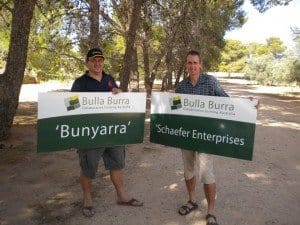
John Gladigau and Robin Schaefer. Movie: Bulla Burra.
Stimulated into action, John sat downwards with good friend and nearby landholder, Robin Schaefer, with whom he had been having similar discussions for a long fourth dimension.
They pulled out a blank sheet of paper and began designing what they saw every bit the 'ideal farm' for their area.
They asked questions such as what would be the most efficient mix of land, machinery, labour and infrastructure for their region, what the most effective business structure would be, what uppercase would be required and how it could be accessed, what roles each individual would play, and how would they become nearly bringing corporate principles into what was essentially a family farming functioning.
They arrived at the post-obit conclusions: An ideal "efficiency cell" for their area was 4000ha of cropping country, with these specific machinery requirements – a 300hp tractor, a 40ft seeder, a 40ft harvester, a sprayer, 3 labour units, two utes, and ane chaser bin.
As a matter of simple coincidence, the Gladigaus already owned 2000ha, and the Schaefers already owned 2000ha nearby, so they finer already had a 4000ha efficiency cell betwixt them.
They too adamant that adding a 2d 4000ha efficiency cell through sharefarming and leasing could achieve even greater efficiency from the outset.
The second prison cell meant they could utilize a single sprayer across the entire 8000ha operation, and, instead of farming a 4000ha surface area with iii labour units, they could farm an 8000ha surface area with 5 labour units.
The Gladigaus and Schaefers set up a new company chosen Bulla Burra and leased their individual farms to the new company.
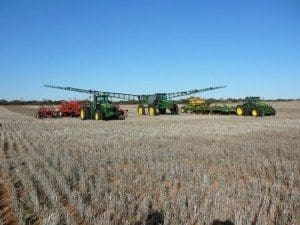
Bulla Burra'south seeding machnery in 2009. Flick: Bulla Burra.
They sold every bit of mechanism they owned between them, and purchased the precise machinery that was required to fit the new operation.
Reflecting their different skill sets, Robin became the practical operations manager, and John became the business and grain marketing manager.
They also established a lath with an independent chairman (Jeff McDonald), to ensure controlling processes remained professional person, accountable and transparent.
Under the Bulla Burra model, John and Robin both receive income from multiple streams:
- As landowners they receive a flexi-lease payment for the land they each own that is leased to the business, based on the production that is accomplished from that land each year;
- As shareholders they receive income every bit a distribution of profits;
- They both receive a commercial wage for their direction and labour roles within Bulla Burra.
Collaborative farming principles at piece of work
During his presentation at Beefiness 2015 John provided several examples of how the principles of successful collaborative farming enterprises distilled from his Nuffield Scholarship experience now underpin the Bulla Burra model.
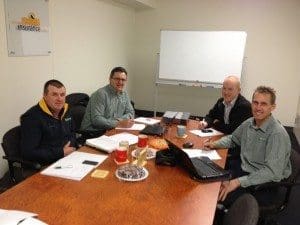
A quarterly Bulla Burra lath meeting with farm manager, Andrew Biele, John Gladigau, independent board chairman Jeff McDonald and Robin Schaefer. Picture: Bulla Burra.
For example, the team holds regular strategy meetings to look at where Bulla Burra is going, where information technology should be in five to x years time, and how it should get there. A strategy chosen "Bulla Burra Amend" has been adopted to better every facet of the operation by 5-10pc. As the business organisation has grown in efficiency so has the size of the 'efficiency cells', which have now been refined and expanded to 4500ha each. This yr – its sixth year of performance – Bulla Burra will farm an surface area of about 11,000ha.
Machinery is utilised efficiently by choosing not necessarily the biggest machines but those best matched to the area existence farmed, and running them around the clock. Bulla Burra's 300hp tractors "effectively don't finish". As soon as they come off a seeder they go onto a spreader, and then at harvest they go onto chaser bins. The sprayer runs on 2 eight hour shifts for well-nigh of the yr. "We push (the sprayer) to the max, it is worth $500,000," John said. "Why take a second one as a back up, why not just utilise it to the absolute max?"
"Purchase your own flaming ute". "So I bought my ain ute. It'southward about having a business approach."
How Bulla Burra works to reach win-wins with key stakeholders is illustrated by its arroyo to transport. When the business was established in 2009 John and Robin committed to giving their entire grain carting work to a unmarried trucking company. Twelvemonth one was a astringent drought year, only despite receiving several offers for cheaper freight from other trucking companies, they stuck with their called transporter. Twelvemonth two was a bumper grain growing yr, and farmers everywhere were struggling to secure the trucks they needed. Bulla Burra had no such problem. "It is about edifice a relationship going forward, it becomes a win-win," John said. "One big primal affair that we have taken out of our six yr journey then far has been the value of relationships – the benefits that have come from those have been far beyond what we originally believed were possible."
John and Robin and have worked out where their skills all-time fit the business, and they use specialists where required to fill in the gaps.
John stresses the importance of having an independent vocalisation to ensure that all decisions are made objectively and are not 'tainted by emotion'.
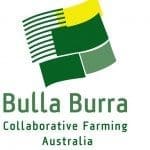 He told this story to illustrate his point: At an early Bulla Burra board meeting, decisions were made about the roles each individual would play and the resource they would need. Robin would exist the full-time operations manager and would need a ute to fulfill that office. John would accept on the role of business director for only 50pc of the time (he was also doing some external freelance work at the time) and would also need a ute. "Hang on!" the contained chairman Jeff quickly intervened, as John recalls. If the business was to hire an external employee to fill that role for simply 50pc of the fourth dimension, Jeff asked, would it still provide that person with a ute? "Probably not," John conceded. "And then you don't get a ute," Jeff said. "How do I become around?," John asked. "Purchase your ain flaming ute," Jeff replied. "And then I bought my own ute," John said. "It is about having a concern approach."
He told this story to illustrate his point: At an early Bulla Burra board meeting, decisions were made about the roles each individual would play and the resource they would need. Robin would exist the full-time operations manager and would need a ute to fulfill that office. John would accept on the role of business director for only 50pc of the time (he was also doing some external freelance work at the time) and would also need a ute. "Hang on!" the contained chairman Jeff quickly intervened, as John recalls. If the business was to hire an external employee to fill that role for simply 50pc of the fourth dimension, Jeff asked, would it still provide that person with a ute? "Probably not," John conceded. "And then you don't get a ute," Jeff said. "How do I become around?," John asked. "Purchase your ain flaming ute," Jeff replied. "And then I bought my own ute," John said. "It is about having a concern approach."
Simply is it profitable?
The most burning question of course is how the model stacks up financially.
To respond this question, John explained that when the business concern started, he and Robin identified that the biggest threat to the fledgling concern would be a drought in year 1.
After v droughts in seven years, they didn't expect to walk direct into a sixth. But they did, and Bulla Bulla'due south first year produced yields of merely 0.6t/ha.
It was a tough time, John recalls, and one where he questioned whether they had fabricated the right determination.
However, after conducting some in-depth analysis comparing their functioning under Bulla Burra with how they would have performed in the same year had they still been running their individual farms, John said he felt some comfort.
The analysis showed that had they nonetheless existence running their 2000ha farms individually, they would take each made a loss that drought year of about $200,000.
Their share of Bulla Burra's loss in that first year was about the aforementioned.
So in the worst scenario they were effectively no worse off.
What gave them more comfort was realising just how much better off they would have been under the Bulla Burra model in an average or higher up boilerplate year due to the scale and efficiency they had created.
Had year i been an boilerplate rainfall season, the analysis showed that every bit individual farmers they would have merely broken even, simply under Bulla Burra they would take made a $100,000 profit.
And had it been an in a higher place average year, the numbers nether the Bulla Burra model were significantly better again. "Obviously that is where the scale comes into it," John said.
In year 2 – 2010 – they had "the best year in history" and averaged 1.8t to the hectare.
As individual farmers, their costs to produce one tonne of wheat were effectually $204/t. Under Bulla Burra, their cost of product was cut to $171/t.
"Nosotros are now running a highly efficient and profitable farming operation," John said.
Improve engineering, more flexibility
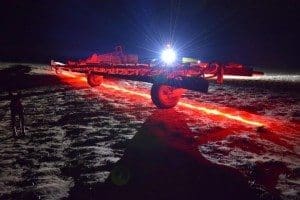
Bulla Burra'south weedit sprayer.
The Mallee farmers are also now able to utilise engineering they never previously believed they would exist able to afford, such as a $250,000 weedit laser-targeted sprayer which merely sprays about 10pc of each paddock and cuts chemical use and costs by 90pc.
Fifty-fifty more than importantly, they now also enjoy a level of flexibility that they had in one case hoped for but had never previously idea possible equally private farmers.
This was highlighted a few years ago when both John and Robin and their families were in the United kingdom – Robin was undertaking his own Nuffield Scholarship tour – and they received a text message with a picture from Bulla Burra showing a newly acquired tractor and seeder in functioning. It would sow g acres before either Robin or John returned home.
"It was at that bespeak we realised we had flexibility in our business and that it could operate without us fifty-fifty being there," John explained.
John said the operation was fortunate to apply groovy staff. Almost all of their staff take been employed out of the horticulture manufacture, because they came into the business with more of a corporate mentality and were more than used to dealing with compliance issues.
"We believe it is far, far easier to teach skills than it is to teach teamwork and values within the business," John said.
Take home letters
So what can cattle producers larn from a South Australian graingrower?
John's take dwelling house letters for cattle producers are these:
Be strategic: "Start off with a blank sheet of newspaper, look at where you lot want your business to be in five years x years, take away the restrictions and preconceptions, and say what could it be like, what practice I desire information technology to be like, what are my goals, what are my dreams, what am I good at, where is the manufacture going and how do I prepare myself up and construction myself to take advantage of that."
Focus on efficiency rather than scale: "Sometimes in order to create efficiencies you need scale. Merely scale doesn't necessarily mean efficiency. In fact scale tin create whole new issues, information technology can create fatty, direction issues, logistics issues etc. The focus has to be on efficiency."
Collaboration takes many forms: "You can collaborate to create scale but you can also interact with every stakeholder inside your business – with your landholders, with y'all employers, with your suppliers, with the people you sell to. Information technology is how we can work together in order to get the nearly benefit, information technology all comes down to creating constructive relationships."
You need an independent voice in your business concern: "Fifty-fifty if y'all are not a collaborative concern, the value of having someone from outside to expect over your business organisation with an objective view that is non tainted by emotion can add then much value to your business."
To learn more about Bulla Burra and to see more great pictures from their performance visit their facebook folio here
Nuffield Commonwealth of australia is besides currently taking applications for 2016 scholarships until June 30 – for more details click here
schoolerhoustent44.blogspot.com
Source: https://www.beefcentral.com/features/beef-2015-report/rethinking-the-family-farm-two-farmers-collaborative-success-story/
0 Response to "Jameson Family Farms (Jff), a Family Owned Business"
Enregistrer un commentaire